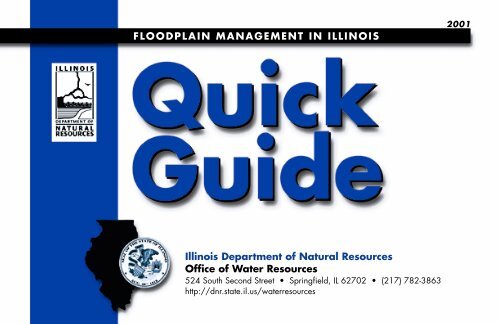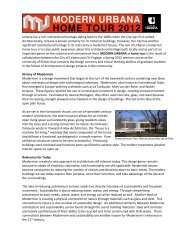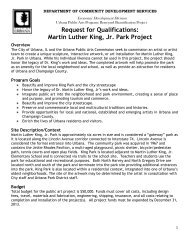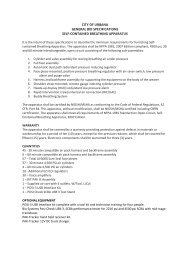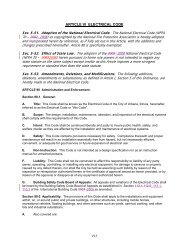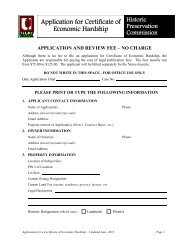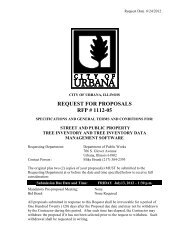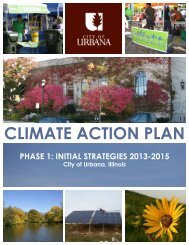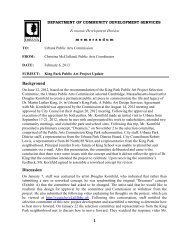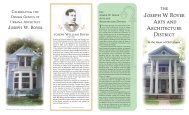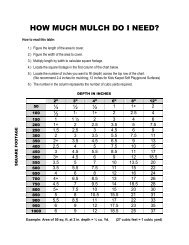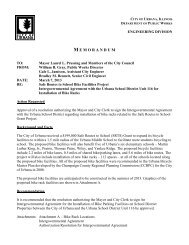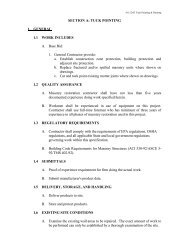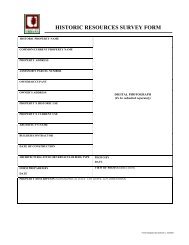Floodplain Management in Illinois - Illinois Department of Natural ...
Floodplain Management in Illinois - Illinois Department of Natural ...
Floodplain Management in Illinois - Illinois Department of Natural ...
Create successful ePaper yourself
Turn your PDF publications into a flip-book with our unique Google optimized e-Paper software.
FLOODPLAIN MANAGEMENT IN ILLINOIS<br />
2001<br />
Ill<strong>in</strong>ois <strong>Department</strong> <strong>of</strong> <strong>Natural</strong> Resources<br />
Office <strong>of</strong> Water Resources<br />
524 South Second Street • Spr<strong>in</strong>gfield, IL 62702 • (217) 782-3863<br />
http://dnr.state.il.us/waterresources
Table <strong>of</strong> Contents<br />
1 ........... About This Guide<br />
2 ........... Why do we Regulate the <strong>Floodpla<strong>in</strong></strong><br />
3 ........... Community Responsibilities<br />
4 ........... Understand<strong>in</strong>g the River<strong>in</strong>e <strong>Floodpla<strong>in</strong></strong><br />
5 ........... Understand<strong>in</strong>g the Floodway<br />
6 ........... The Countywide Flood Insurance Rate Map<br />
7 ........... The Flood Insurance Rate Map<br />
8 ........... Use the Flood Pr<strong>of</strong>ile to Determ<strong>in</strong>e BFEs<br />
9 ........... Approximate Flood Zones<br />
10 ......... Flood Map Revisions<br />
11 ......... <strong>Floodpla<strong>in</strong></strong> Development Includes<br />
12 ......... Safe Uses <strong>of</strong> the <strong>Floodpla<strong>in</strong></strong><br />
13 ......... What is the Elevation Certificate and How is it Used<br />
14 ......... Complet<strong>in</strong>g the Elevation Certificate<br />
15 ......... Is Your Land Higher than the BFE<br />
16 ......... What is Meant by “Pre-FIRM” and “Post-FIRM”<br />
17 ......... Nature Doesn’t Read Maps<br />
18 ......... Go the Extra Foot!<br />
19 ......... Some Key Permit Review Steps<br />
20 ......... Carefully Complete the Permit Application<br />
21 ......... Floodway Development Proposals<br />
22 ......... <strong>Floodpla<strong>in</strong></strong> Fill Can Make Th<strong>in</strong>gs Worse<br />
23 ......... How to Elevate Your <strong>Floodpla<strong>in</strong></strong> Build<strong>in</strong>g<br />
24 ......... A Basement is Not a Good Idea<br />
25 ......... Manufactured Homes Deserve Special Attention<br />
26 ......... Enclosures Below BFE<br />
27 ......... Utility Service for Build<strong>in</strong>gs<br />
28 ......... Accessory Structures<br />
29 ......... Recreational Vehicles<br />
30 ......... Agricultural Structures<br />
31 ......... Plann<strong>in</strong>g to Improve Your <strong>Floodpla<strong>in</strong></strong> Build<strong>in</strong>g<br />
32 ......... What About After Damages<br />
33 ......... Elevat<strong>in</strong>g a Pre-FIRM Build<strong>in</strong>g<br />
34 ......... Th<strong>in</strong>k Carefully About Variances<br />
35 ......... Paperwork is Important – for You and Your Community<br />
36 ......... Some Flood Protection for Older Homes is Easy and Low Cost<br />
37 ......... Some Flood Mitigation Projects are More Costly<br />
38 ......... Want to Learn More<br />
ILLINOIS QUICK GUIDE
About This Guide<br />
The <strong>Floodpla<strong>in</strong></strong> <strong>Management</strong> Quick Guide was orig<strong>in</strong>ally prepared by<br />
our friends and neighbors at the Missouri State Emergency <strong>Management</strong><br />
Agency. The State <strong>of</strong> Missouri has graciously allowed it to be edited<br />
and modified for use <strong>in</strong> Ill<strong>in</strong>ois. Copyright laws do not apply.<br />
The development <strong>of</strong> this Quick Guide was supported by fund<strong>in</strong>g from<br />
our partners at the Federal Emergency <strong>Management</strong> Agency (FEMA).<br />
The contents may not necessarily reflect the views and policies <strong>of</strong> the<br />
Federal government.<br />
Questions and comments can be directed to the Ill<strong>in</strong>ois <strong>Department</strong><br />
<strong>of</strong> <strong>Natural</strong> Resources/Office <strong>of</strong> Water Resources (IDNR/OWR) at<br />
(217) 782-3862. We encourage any comments and suggestions for<br />
improvements to this Guide. For additional copies, please call<br />
IDNR/OWR.<br />
The Ill<strong>in</strong>ois <strong>Floodpla<strong>in</strong></strong> <strong>Management</strong>: Local <strong>Floodpla<strong>in</strong></strong> Adm<strong>in</strong>istrator’s Manual and other publications on<br />
floodpla<strong>in</strong> management are available from IDNR, and other documents are available from FEMA.<br />
Please contact us if you have questions or need further assistance.<br />
1<br />
ILLINOIS QUICK GUIDE
Why Do We Regulate the <strong>Floodpla<strong>in</strong></strong><br />
To protect people and property. <strong>Floodpla<strong>in</strong></strong> management is about build<strong>in</strong>g smart. It makes good sense. If we<br />
know part <strong>of</strong> our land will flood from time to time, shouldn’t we make reasonable decisions to help protect our<br />
families, homes, and bus<strong>in</strong>esses<br />
To make sure that federal flood <strong>in</strong>surance and disaster assistance are available. If your home or<br />
bus<strong>in</strong>ess is <strong>in</strong> the floodpla<strong>in</strong>, and federal flood <strong>in</strong>surance isn’t available, then you can’t get some types <strong>of</strong> federal<br />
f<strong>in</strong>ancial assistance. Mortgages will be hard to f<strong>in</strong>d, and you won’t be able to get some types <strong>of</strong> state and federal<br />
loans and grants.<br />
To save tax dollars. Every flood disaster affects the town’s budget. If we build smarter, we’ll have fewer<br />
problems the next time the river rises. Remember, federal disaster assistance doesn’t kick <strong>in</strong> for all floods. And<br />
even when the President declares a disaster, your community still has to pay a lot to cover the costs <strong>of</strong> evacuation,<br />
temporary hous<strong>in</strong>g, repair, and clean-up.<br />
To avoid liability and law suits. If we know an area is mapped as floodpla<strong>in</strong> and likely to flood — if we know<br />
people could be <strong>in</strong> danger — if we know that build<strong>in</strong>gs could be damaged, doesn’t it make sense to take<br />
reasonable protective steps when we develop and build<br />
To reduce future flood losses <strong>in</strong> Ill<strong>in</strong>ois. The laws <strong>in</strong> Ill<strong>in</strong>ois are simply a “good neighbor” policy designed to<br />
protect our citizens from future flood losses. It is illegal to do any floodway activity that may <strong>in</strong>crease or divert<br />
flood waters onto neighbor<strong>in</strong>g properties. These laws help keep flood<strong>in</strong>g conditions from gett<strong>in</strong>g worse as more<br />
and more development takes place.<br />
2<br />
ILLINOIS QUICK GUIDE
Community Responsibilities<br />
To participate <strong>in</strong> the National Flood Insurance Program, your community agrees to:<br />
Adopt and enforce a <strong>Floodpla<strong>in</strong></strong> management ord<strong>in</strong>ance<br />
Require permits for all types <strong>of</strong> development <strong>in</strong> the <strong>Floodpla<strong>in</strong></strong> (see page 11)<br />
Assure that build<strong>in</strong>g sites are reasonably safe from flood<strong>in</strong>g<br />
Require new or improved homes and manufactured homes to be<br />
elevated above the Base Flood Elevation (BFE)<br />
Require other build<strong>in</strong>gs to be elevated or floodpro<strong>of</strong>ed<br />
Conduct field <strong>in</strong>spections and cite violations<br />
Require Elevation Certificates to document compliance (see pages 13 and 14)<br />
Carefully consider requests for variances<br />
Advise FEMA when updates to Flood maps are needed<br />
3<br />
ILLINOIS QUICK GUIDE
Understand<strong>in</strong>g the River<strong>in</strong>e <strong>Floodpla<strong>in</strong></strong><br />
Fr<strong>in</strong>ge<br />
<strong>Floodpla<strong>in</strong></strong><br />
Floodway<br />
Stream<br />
Channel<br />
Fr<strong>in</strong>ge<br />
Terms and<br />
Def<strong>in</strong>itions<br />
The <strong>Floodpla<strong>in</strong></strong> is the land that is<br />
subject to a 1%-annual-chance<br />
or greater chance <strong>of</strong> flood<strong>in</strong>g <strong>in</strong><br />
any given year. On FIRMs and<br />
Floodway maps, the <strong>Floodpla<strong>in</strong></strong><br />
may be designated as Zones A,<br />
AO, AH, A1-30, AE, or A99.<br />
See page 5, Understand<strong>in</strong>g the<br />
Floodway, to learn about the<br />
area <strong>of</strong> the floodpla<strong>in</strong> where<br />
floodwaters usually flow faster<br />
and deeper.<br />
For <strong>Floodpla<strong>in</strong></strong>s with Base Flood Elevations, check the Flood Insurance Study to f<strong>in</strong>d the Flood Pr<strong>of</strong>ile which shows<br />
water surface elevations for different frequency floods ( see page 8).<br />
4<br />
ILLINOIS QUICK GUIDE
Understand<strong>in</strong>g the Floodway<br />
A<br />
Flood<br />
Fr<strong>in</strong>ge<br />
Simulated<br />
Encroachment<br />
*Surcharge not to exceed 0.1 foot [Ill<strong>in</strong>ois requirement]<br />
C<br />
Area <strong>of</strong> floodpla<strong>in</strong> that could be<br />
used for development by rais<strong>in</strong>g ground<br />
L<strong>in</strong>e<br />
L<strong>in</strong>e<br />
A<br />
C<br />
<strong>Floodpla<strong>in</strong></strong><br />
B<br />
D<br />
Floodway<br />
Stream<br />
Channel<br />
Surcharge*<br />
D<br />
Flood<br />
Fr<strong>in</strong>ge<br />
Simulated<br />
Encroachment<br />
= Flood Elevation Before Encroachment<br />
= Flood Elevation After Encroachment<br />
B<br />
Flood elevation before<br />
encroachment<br />
Simulated Encroachment<br />
Terms and<br />
Def<strong>in</strong>itions<br />
The Floodway is the channel <strong>of</strong> a river<br />
or other watercourse and the adjacent<br />
land areas that must be reserved <strong>in</strong><br />
order to pass the base flood without<br />
<strong>in</strong>creas<strong>in</strong>g the water surface elevation<br />
more than a designated height.<br />
Computer models <strong>of</strong> the floodpla<strong>in</strong><br />
are used to simulate “encroachment”<br />
or fill <strong>in</strong> the flood fr<strong>in</strong>ge <strong>in</strong> order to<br />
predict where and how much the<br />
base flood elevation would <strong>in</strong>crease if<br />
the floodpla<strong>in</strong> is allowed to be filled.<br />
In Ill<strong>in</strong>ois, the Floodway boundary is<br />
drawn where the computer model<br />
<strong>in</strong>dicates that the water surface will<br />
<strong>in</strong>crease 0.1' due to the simulated<br />
encroachment.<br />
For Floodway proposals, before a local floodpla<strong>in</strong> permit can be issued a State <strong>of</strong> Ill<strong>in</strong>ois Permit<br />
must be obta<strong>in</strong>ed. You may need a qualified eng<strong>in</strong>eer to make sure your<br />
proposed project won’t <strong>in</strong>crease flood<strong>in</strong>g on others.<br />
5<br />
ILLINOIS QUICK GUIDE
The Countywide Flood Insurance Rate Map<br />
Newer FIRMs comb<strong>in</strong>e counties and<br />
<strong>in</strong>corporated municipalities, so match<strong>in</strong>g<br />
across boundaries isn’t a problem.<br />
The Floodway is the ”cross-hatched”<br />
area<br />
ZONE AE is the 100-year<br />
(1%-annual-chance) floodpla<strong>in</strong><br />
ZONE X (shaded) shows areas<br />
affected by the 500-year flood<br />
(formerly B Zone)<br />
1<br />
2<br />
3<br />
ZONE X (unshaded) is all other areas<br />
(formerly C Zone)<br />
4<br />
The Floodway is the area where most conveyance and velocity flows occur.<br />
In Ill<strong>in</strong>ois, very specific laws govern the use <strong>of</strong> Floodways (see page 5).<br />
6<br />
ILLINOIS QUICK GUIDE
The Flood Insurance Rate Map<br />
NOTE:<br />
This FIRM does not<br />
show a floodway<br />
(see page 6).<br />
1<br />
2<br />
3<br />
4<br />
5<br />
BASE FLOOD ELEVATION (BFE).<br />
Water surface elevation (<strong>in</strong> feet above datum) <strong>of</strong><br />
the base flood at specific locations (cross-sections).<br />
ELEVATION REFERENCE MARKS (RM).<br />
Po<strong>in</strong>ts for which ground elevation data have been<br />
established and recorded on the FIRM or <strong>in</strong> the<br />
Flood Insurance Study.<br />
FLOOD HAZARD ZONES.<br />
Zone A, Zones A1-A30, and Zone AE are<br />
subject to flood<strong>in</strong>g by the base or 100-year flood<br />
(1% annual chance).<br />
Zone B is subject to flood<strong>in</strong>g by the 500-year<br />
flood (0.2% annual chance).<br />
Zone C is all other areas.<br />
FEMA prepares Flood Insurance Rate Maps to show<br />
areas that are predicted to flood after <strong>in</strong>tense or<br />
major storms. The FIRMs estimate how high the water<br />
may rise, called the Base Flood Elevation.<br />
7<br />
ILLINOIS QUICK GUIDE
Use the Flood Pr<strong>of</strong>ile to Determ<strong>in</strong>e BFEs<br />
1<br />
Road<br />
Flood pr<strong>of</strong>iles can be used<br />
to determ<strong>in</strong>e the BFE at a<br />
specific site. Pr<strong>of</strong>iles also<br />
show predicted water<br />
surface elevations for floods<br />
other than the 100-year<br />
flood.<br />
2 1<br />
On the Flood Insurance<br />
Rate Map, locate your site<br />
by measur<strong>in</strong>g the distance,<br />
along the stream channel,<br />
from a cross section,<br />
for example, or .<br />
1<br />
2<br />
Scale that distance on the<br />
Flood Pr<strong>of</strong>ile and read up<br />
to the pr<strong>of</strong>ile <strong>of</strong> <strong>in</strong>terest,<br />
then across to determ<strong>in</strong>e<br />
the elevation.<br />
8<br />
ILLINOIS QUICK GUIDE
Approximate Flood Zones<br />
Approximate flood zones are<br />
drawn based on exist<strong>in</strong>g<br />
<strong>in</strong>formation, not eng<strong>in</strong>eer<strong>in</strong>g<br />
studies. FEMA checked with the<br />
U.S. Army Corps <strong>of</strong> Eng<strong>in</strong>eers, the<br />
U.S. Geological Survey, the State,<br />
local <strong>of</strong>ficials, and sources <strong>of</strong><br />
historic records. When exist<strong>in</strong>g<br />
<strong>in</strong>formation was lack<strong>in</strong>g, an<br />
approximation analysis was<br />
performed.<br />
Topographic maps can be used to estimate the Base Flood Elevation.<br />
If you need help determ<strong>in</strong><strong>in</strong>g the<br />
BFE, check with your community<br />
permit <strong>of</strong>fice, FEMA or IDNR/<br />
OWR. FEMA publication<br />
Manag<strong>in</strong>g <strong>Floodpla<strong>in</strong></strong><br />
Development <strong>in</strong> Approximate<br />
Zone A Areas (FEMA 265) is<br />
useful for eng<strong>in</strong>eers. The Ill<strong>in</strong>ois<br />
State Water Survey may be able<br />
to determ<strong>in</strong>e a BFE for a<br />
m<strong>in</strong>imal fee, (217) 333-0447.<br />
9<br />
ILLINOIS QUICK GUIDE
Flood Map Revisions<br />
There Are Three Primary Types <strong>of</strong> Flood Map Revisions<br />
1.<br />
2.<br />
Letter <strong>of</strong> Map Amendment (LOMA) – issued when a property owner<br />
demonstrates that the natural ground is higher than the BFE (see page 15).<br />
Lenders may waive the flood <strong>in</strong>surance requirement if the LOMA documents<br />
that a home is not <strong>in</strong> the mapped floodpla<strong>in</strong>.<br />
Letter <strong>of</strong> Map Revision Based on Fill (LOMR-F) – issued when fill has been<br />
placed to raise the land above the BFE. For multiple lots, the applicant must<br />
certify compaction <strong>of</strong> the fill. Lenders can waive the <strong>in</strong>surance requirement if<br />
the LOMR-F demonstrates that homes on fill are above the BFE.<br />
Important<br />
Information<br />
Check FEMA’s Flood<br />
Hazard Mapp<strong>in</strong>g Web<br />
Site for more<br />
<strong>in</strong>formation about map<br />
revisions concern<strong>in</strong>g<br />
Homeowners<br />
3.<br />
Physical Map Revision (LOMR PMR) – issued for floodpla<strong>in</strong> changes that<br />
require eng<strong>in</strong>eer<strong>in</strong>g analyses, such as bridges, culverts, channel changes,<br />
flood control measures, and large fills that change the BFE or Floodway.<br />
Physical map revisions are also issued when a new study updates or<br />
improves the FIRM.<br />
and<br />
Eng<strong>in</strong>eers/Surveyors.<br />
www.fema.gov/mit/tsd<br />
10<br />
ILLINOIS QUICK GUIDE
<strong>Floodpla<strong>in</strong></strong> Development Includes:<br />
Construction <strong>of</strong> new build<strong>in</strong>gs<br />
Additions to exist<strong>in</strong>g build<strong>in</strong>gs<br />
Substantial improvement <strong>of</strong> exist<strong>in</strong>g build<strong>in</strong>gs<br />
Placement <strong>of</strong> manufactured (mobile) homes<br />
Subdivision <strong>of</strong> land<br />
Temporary build<strong>in</strong>gs and accessory structures.<br />
Agricultural build<strong>in</strong>gs<br />
Recreational vehicles<br />
Storage <strong>of</strong> materials, <strong>in</strong>clud<strong>in</strong>g gas/liquid tanks<br />
Roads, bridges, and culverts<br />
Fill, grad<strong>in</strong>g, excavation, m<strong>in</strong><strong>in</strong>g, and dredg<strong>in</strong>g<br />
Alter<strong>in</strong>g stream channels<br />
YOU NEED PERMITS FOR ALL OF THESE ACTIVITIES.<br />
11<br />
ILLINOIS QUICK GUIDE
Safe Uses <strong>of</strong> the <strong>Floodpla<strong>in</strong></strong><br />
All land subdivided <strong>in</strong>to lots, some lots<br />
partially <strong>in</strong> the <strong>Floodpla<strong>in</strong></strong>, setbacks<br />
modified to keep homesites on high ground.<br />
RECOMMENDED<br />
All land subdivided <strong>in</strong>to lots, some<br />
homesites and lots partially or<br />
entirely <strong>in</strong> the <strong>Floodpla<strong>in</strong></strong>.<br />
NOT RECOMMENDED<br />
<strong>Floodpla<strong>in</strong></strong> land put <strong>in</strong>to public/<br />
common open space, net density<br />
rema<strong>in</strong>s, lot sizes reduced and<br />
setbacks modified to keep<br />
homesites on high ground.<br />
RECOMMENDED<br />
If possible, keep it natural open space – let the floodpla<strong>in</strong> do its job. Other low damage uses: recreational areas,<br />
playgrounds, reforestation, park<strong>in</strong>g, gardens, pasture, accessory structures, created wetlands.<br />
12<br />
ILLINOIS QUICK GUIDE
What is the Elevation Certificate and How is it Used<br />
The Elevation Certificate (EC) is a FEMA form.<br />
The EC must be completed by a registered surveyor or eng<strong>in</strong>eer when the<br />
floodpla<strong>in</strong> has BFEs.<br />
A community <strong>of</strong>ficial may complete the EC for sites <strong>in</strong> approximate flood zones.<br />
It can be used to show that sites are natural ground above the base flood<br />
elevation (see page 15).<br />
It is used to verify that build<strong>in</strong>gs are elevated properly (see page 20).<br />
Insurance agents use the EC to write flood <strong>in</strong>surance policies (see page 35).<br />
By itself, the EC cannot be used to waive the requirement to get flood<br />
<strong>in</strong>surance. See page 10 to learn about Letters <strong>of</strong> Map Amendment.<br />
13<br />
ILLINOIS QUICK GUIDE
Complet<strong>in</strong>g the Elevation Certificate<br />
Elevation Certificate (partial)<br />
RM166<br />
In this example, the BFE is 485.<br />
486 0<br />
n/a<br />
n/a<br />
482 5<br />
486 0<br />
482 5<br />
486 0<br />
three<br />
386<br />
(g)<br />
x<br />
(a)<br />
(e)<br />
ATTACHED GARAGE<br />
ELECTRICAL BOX<br />
WIRED FROM<br />
CEILING<br />
BFE<br />
The slab-on-grade house was elevated<br />
on fill 1’ above the BFE, and the<br />
vented garage is 2.5’ below the BFE<br />
COMPACTED FILL<br />
FLOOD OPENING<br />
HOT WATER HEATER<br />
ELEVATED ON A<br />
PLATFORM<br />
(f)<br />
(d)<br />
You will get a blank Elevation Certificate form when you get your permit. You must have a surveyor or eng<strong>in</strong>eer fill it out<br />
and seal it. The Elevation Certificate <strong>in</strong>cludes diagrams for eight build<strong>in</strong>gs types. Several po<strong>in</strong>ts must be surveyed.<br />
14<br />
ILLINOIS QUICK GUIDE
Is Your Land Higher than the BFE<br />
Sealed Signature<br />
ELEVATION<br />
CERTIFICATE<br />
Lowest Adjacent<br />
Grade Higher<br />
Than BFE<br />
LOMA<br />
LOWEST<br />
ADJACENT GRADE<br />
Your Lot IS<br />
Above The BFE…<br />
Not Required<br />
To Buy<br />
Flood Insurance<br />
BFE<br />
If your land is shown on the map as “<strong>in</strong>” the <strong>Floodpla<strong>in</strong></strong>, but your build<strong>in</strong>g site is higher than the BFE…<br />
get a surveyor to fill <strong>in</strong> the FEMA Elevation Certificate. FEMA may issue a Letter <strong>of</strong> Map Amendment.<br />
This is the ONLY way to remove the requirement to buy flood <strong>in</strong>surance.<br />
Keep the EC with your deed, it will help future buyers.<br />
15<br />
ILLINOIS QUICK GUIDE
What is Meant by Pre-FIRM and Post-FIRM<br />
Pre-FIRM<br />
(Older Build<strong>in</strong>gs<br />
usually are not elevated)<br />
FIRST FLOOR<br />
AND LOWEST FLOOR<br />
BFE<br />
Post-FIRM<br />
(Newer build<strong>in</strong>gs are elevated)<br />
FIRST FLOOR<br />
AND LOWEST FLOOR<br />
A build<strong>in</strong>g is Pre-FIRM if it was built before your community adopted the flood ord<strong>in</strong>ance<br />
and Flood Insurance Rate Map.<br />
If is was built after adoption, it is Post-FIRM.<br />
Improvements or repairs to Pre-FIRM build<strong>in</strong>gs may require permits (see pages 31 and 32).<br />
16<br />
ILLINOIS QUICK GUIDE
Nature Doesn’t Read Maps<br />
Important<br />
Information<br />
500-year<br />
elevation<br />
100-year<br />
elevation<br />
10-year<br />
elevation<br />
Many people don’t<br />
understand just how<br />
risky the floodpla<strong>in</strong><br />
can be. There is a<br />
26% chance that a<br />
home <strong>in</strong> the <strong>Floodpla<strong>in</strong></strong><br />
will flood dur<strong>in</strong>g a<br />
30-year mortgage<br />
period. The chance<br />
that a major fire will<br />
occur dur<strong>in</strong>g the same<br />
period is only 1%!<br />
CAUTION! Nature doesn’t read the flood map! Rare major storms cause flood<strong>in</strong>g that rises higher than the BFE.<br />
Consider safety – protect your home or bus<strong>in</strong>ess by build<strong>in</strong>g higher.<br />
See page 18 to see how this will save you money on <strong>in</strong>surance.<br />
17<br />
ILLINOIS QUICK GUIDE
Go the Extra Foot!<br />
Want to save some money and have peace <strong>of</strong> m<strong>in</strong>d at the same time<br />
Then build higher than the m<strong>in</strong>imum elevation requirement!<br />
Lowest Floor Relative to BFE<br />
18<br />
+2<br />
+1<br />
BFE<br />
–1<br />
–2<br />
B<br />
$1,000<br />
House A on vented crawlspace<br />
Post-FIRM <strong>in</strong> AE Zone with BFE<br />
$100,000 <strong>in</strong>surance on the build<strong>in</strong>g<br />
$40,000 <strong>in</strong>surance on contents<br />
House B MFH on re<strong>in</strong>forced pil<strong>in</strong>gs<br />
Post-FIRM <strong>in</strong> A Zone with BFE<br />
$40,000 <strong>in</strong>surance on unit<br />
$20,000 <strong>in</strong>surance on contents<br />
A<br />
Annual Flood Insurance Cost<br />
$2,000 $3,000<br />
SUBMIT TO<br />
FEMA IF<br />
2 OR MORE<br />
FEET BELOW<br />
BFE<br />
Important<br />
Information<br />
NOTE: Flood <strong>in</strong>surance<br />
rates and various fees<br />
change from time to time.<br />
Rather than specific costs for<br />
<strong>in</strong>surance, this figure gives a<br />
feel for how much difference<br />
just a foot or two can make.<br />
Build<strong>in</strong>g owners will save<br />
<strong>in</strong>surance money if they<br />
elevate above the BFE. But<br />
more impressive is how the<br />
cost <strong>of</strong> <strong>in</strong>surance nearly<br />
doubles if the build<strong>in</strong>g is<br />
only one foot below the BFE.<br />
Remember! The community<br />
may be able to grant a<br />
variance, but the owner may<br />
still have to buy <strong>in</strong>surance.<br />
Imag<strong>in</strong>e try<strong>in</strong>g to sell a<br />
house if the bank requires<br />
<strong>in</strong>surance that costs over<br />
$2,000 a year!<br />
ILLINOIS QUICK GUIDE
Some Key Permit Review Steps<br />
The Permit Reviewer has to Check Many Th<strong>in</strong>gs.<br />
Some <strong>of</strong> the Key Questions are:<br />
Is the site <strong>in</strong> the mapped <strong>Floodpla<strong>in</strong></strong><br />
Is the site <strong>in</strong> the mapped Floodway<br />
Has an IDNR/OWR permit been obta<strong>in</strong>ed<br />
Have other State and Federal permits been obta<strong>in</strong>ed<br />
Does the site plan show the Base Flood Elevation<br />
Review Checklist<br />
<strong>Floodpla<strong>in</strong></strong><br />
Floodway<br />
BFE<br />
New Construction<br />
Elevated<br />
Is improvement <strong>of</strong> an older build<strong>in</strong>g proposed<br />
Will new build<strong>in</strong>gs and utilities be elevated properly<br />
Elevation Certificiate<br />
Issue Permit<br />
Will manufactured homes be properly elevated and anchored<br />
Has the owner submitted an Elevation Certificate<br />
19<br />
ILLINOIS QUICK GUIDE
Carefully Complete the Permit Application<br />
Good <strong>in</strong>formation will lead to better construction and less exposure to future flood damage.<br />
20<br />
ILLINOIS QUICK GUIDE
Floodway Development Proposals<br />
For Floodway proposals, before a local<br />
floodpla<strong>in</strong> permit can be issued a State <strong>of</strong><br />
Ill<strong>in</strong>ois Jo<strong>in</strong>t Permit must be obta<strong>in</strong>ed.<br />
You may need a qualified eng<strong>in</strong>eer to make<br />
sure your proposed project won’t <strong>in</strong>crease<br />
flood<strong>in</strong>g on others.<br />
Important<br />
Information<br />
In the six-county area<br />
around Chicago,<br />
only specific openspace<br />
or water<br />
dependent<br />
appropriate uses are<br />
allowed <strong>in</strong> the<br />
Floodway. Be sure to<br />
contact IDNR/OWR<br />
before ANY<br />
Floodway<br />
development.<br />
21<br />
ILLINOIS QUICK GUIDE
<strong>Floodpla<strong>in</strong></strong> Fill Can Make Th<strong>in</strong>gs Worse<br />
<strong>Floodpla<strong>in</strong></strong>s are supposed to store floodwater. If storage space is filled with dirt and other fill,<br />
future flood<strong>in</strong>g may be worsened. Your community may require an eng<strong>in</strong>eer<strong>in</strong>g analysis<br />
to show how floodpla<strong>in</strong> fill will alter flood<strong>in</strong>g.<br />
<strong>Natural</strong> <strong>Floodpla<strong>in</strong></strong><br />
FILL<br />
Obstructed With Fill<br />
Make sure your floodpla<strong>in</strong> fill project won’t harm your neighbors.<br />
In Ill<strong>in</strong>ois, very specific laws govern the use <strong>of</strong> Floodways (see page 5 and 21).<br />
22<br />
ILLINOIS QUICK GUIDE
How to Elevate Your <strong>Floodpla<strong>in</strong></strong> Build<strong>in</strong>g<br />
Elevate on Foundation Walls<br />
Elevate on Fill<br />
SERVICE<br />
EQUIPMENT<br />
SUCH AS UTILITIES AND<br />
ELECTRICAL CIRCUITS,<br />
ABOVE FLOOD<br />
LEVEL<br />
ENCLOSED AREA<br />
USED ONLY FOR<br />
PARKING, ACCESS,<br />
OR LIMITED STORAGE<br />
SERVICE<br />
EQUIPMENT<br />
SUCH AS UTILITIES<br />
AND ELECTRICAL<br />
CIRCUITS<br />
OPENINGS ON<br />
EACH WALL ENSURE<br />
ENTRY OF WATER TO<br />
EQUALIZE HYDROSTATIC<br />
PRESSURE<br />
BFE<br />
2<br />
1<br />
COMPACTED FILL<br />
AT LEAST 10'–15' BEYOND HOUSE<br />
CAUTION! Crawlspaces and other enclosures have some special requirements, see page 26.<br />
Note: When a build<strong>in</strong>g is at the m<strong>in</strong>imum elevation, under-floor utilities are not allowed.<br />
23<br />
ILLINOIS QUICK GUIDE
A Basement is NOT a Good Idea<br />
FIRST FLOOR<br />
DOOR<br />
FIRST FLOOR<br />
DOOR<br />
GROUND<br />
LIVING AREA<br />
BASEMENT WINDOW<br />
LIVING AREA<br />
FILL LEVEL<br />
SUBGRADE<br />
BASEMENT<br />
Terms and<br />
Def<strong>in</strong>itions<br />
A basement is any<br />
area that is below<br />
grade on all sides. A<br />
crawl space is a<br />
basement if the <strong>in</strong>terior<br />
grade is lower than the<br />
exterior grade.<br />
SATURATED FILL<br />
Basements are not allowed <strong>in</strong> new development and flood <strong>in</strong>surance coverage is very<br />
limited <strong>in</strong> exist<strong>in</strong>g basements for a very good reason. It only takes an <strong>in</strong>ch <strong>of</strong> water over<br />
the sill and the entire basement fills up! Excavat<strong>in</strong>g a basement <strong>in</strong>to fill doesn’t always<br />
make it safe because saturated ground water can damage the walls.<br />
24<br />
ILLINOIS QUICK GUIDE
Manufactured Homes Deserve Special Attention<br />
OVER-THE-TOP<br />
FRAME STRAP<br />
ELEVATED<br />
UTILITY<br />
PLATFORM<br />
Experience shows that manufactured<br />
homes are easily damaged. As little<br />
as one foot <strong>of</strong> water can cause<br />
substantial damage.<br />
Dry stacked blocks are not<br />
acceptable — they will NOT<br />
withstand a flood.<br />
BFE<br />
GROUND<br />
CONCRETE<br />
FILLED<br />
CINDERBLOCK<br />
HELICAL GROUND ANCHORS<br />
#5 DOWELS<br />
Manufactured homes must be anchored to resist flotation, collapse, or lateral<br />
movement by be<strong>in</strong>g tied down <strong>in</strong> accordance with the Rules and Regulations<br />
for the Ill<strong>in</strong>ois Mobile Home Tie-Down Act<br />
(77 IL Adm<strong>in</strong>istrative Code 870, IL Dept. <strong>of</strong> Public Health).<br />
3- #4 REINF.<br />
EACH WAY<br />
CONCRETE<br />
FOOTER<br />
BELOW<br />
FROST LINE<br />
8"<br />
MIN.<br />
25<br />
ILLINOIS QUICK GUIDE
Enclosures Below the BFE<br />
NOTE:<br />
TOTAL OPENING AREA IS 1 SQ. IN.<br />
PER SQ. FT. A 25' X 45' BUILDING<br />
NEEDS 1125 SQ. INCHES OF<br />
OPENINGS<br />
LOWEST<br />
FLOOR<br />
BFE<br />
INTERIOR GROUND<br />
LEVEL AT OR<br />
ABOVE<br />
OUTSIDE GRADE<br />
CRAWLSPACE<br />
BUILDING<br />
AT LEAST TWO FLOOD OPENINGS<br />
ON DIFFERENT SIDES<br />
NO MORE THAN 1'<br />
ABOVE GROUND<br />
Solid perimeter wall foundations can enclose flood-prone space. A crawlspace is a good way to elevate<br />
just a couple <strong>of</strong> feet. In all cases, the follow<strong>in</strong>g are required: open<strong>in</strong>gs/vents, elevated utilities,<br />
flood resistant materials, and limitations on use.<br />
26<br />
ILLINOIS QUICK GUIDE
Utility Service for Build<strong>in</strong>gs<br />
ATTACHED GARAGE<br />
BFE<br />
ELECTRICAL BOX<br />
WIRED FROM<br />
CEILING<br />
BFE<br />
OPENING FOR<br />
FLOOD WATER<br />
FLOOD OPENING<br />
HOT WATER HEATER<br />
ELEVATED ON A PLATFORM<br />
All utilities, appliances, and equipment must be elevated<br />
above the BFE or protected. Utilities <strong>in</strong>clude plumb<strong>in</strong>g,<br />
electrical, gas l<strong>in</strong>es, heat<strong>in</strong>g, and air condition<strong>in</strong>g.<br />
27<br />
ILLINOIS QUICK GUIDE
Accessory Structures<br />
Not habitable<br />
Anchored<br />
Flood open<strong>in</strong>gs/vents<br />
Limited <strong>in</strong>vestment value (less than $5,000)<br />
Less than 500 square feet<br />
BFE<br />
Built <strong>of</strong> flood resistant materials<br />
ELEVATED<br />
UTILITIES<br />
Elevated utilities<br />
Used only for storage or park<strong>in</strong>g<br />
Cannot be modified for different<br />
use <strong>in</strong> the future<br />
Document floor elevation<br />
FLOOD OPENINGS<br />
Even small build<strong>in</strong>gs are “development” and permits or variances with noted conditions are required.<br />
They must be elevated or anchored and built to withstand flood damage.<br />
Caution! Remember, everyth<strong>in</strong>g <strong>in</strong>side is likely to get wet when flood<strong>in</strong>g occurs.<br />
28<br />
ILLINOIS QUICK GUIDE
Recreational Vehicles<br />
In a flood hazard area, an RV must:<br />
Be licensed and titled as an RV or park model<br />
(not as a permanent residence)<br />
Have <strong>in</strong>flated wheels and be self-propelled or towable<br />
by light truck<br />
Have no attached deck, porch, shed<br />
Not be used as a permanent dwell<strong>in</strong>g<br />
Be less than 400 sq ft <strong>in</strong> area<br />
Have quick-disconnect propane tank<br />
Have elevated, quick-disconnect sewer service<br />
Have elevated electrical service and air condition<strong>in</strong>g unit<br />
Important<br />
Information<br />
Camp<strong>in</strong>g near the water<br />
Ask the campground or RV park operator<br />
about flood warn<strong>in</strong>gs and plans for safe evacuations.<br />
RVs that do not meet these conditions must be <strong>in</strong>stalled and elevated like Manufactured Homes,<br />
<strong>in</strong>clud<strong>in</strong>g permanent foundations and tie-downs (see page 25)<br />
29<br />
ILLINOIS QUICK GUIDE
Agricultural Structures<br />
Variances are allowed for:<br />
Pole frame build<strong>in</strong>gs<br />
Steel gra<strong>in</strong> b<strong>in</strong>s<br />
Steel frame corn cribs<br />
General purpose feed<strong>in</strong>g barns open<br />
on one side<br />
Variances are not allowed for:<br />
Livestock conf<strong>in</strong>ement build<strong>in</strong>gs<br />
Poultry houses<br />
Dairy operations<br />
Similar livestock operations<br />
IL<br />
State Specific<br />
Guidance<br />
Important<br />
Information<br />
Farm houses are not<br />
agricultural structures.<br />
Contact IDNR/OWR<br />
for additional guidance<br />
on variances for<br />
agricultural structures.<br />
Non-elevated agricultural structures must be considered on a sitespecific<br />
basis and may be permitted only by a variance. Applicants<br />
must show that sites are <strong>in</strong> “wide, expansive floodpla<strong>in</strong> areas” and<br />
no other alternative location outside <strong>of</strong> the <strong>Floodpla<strong>in</strong></strong> exists.<br />
The best flood protection is to elevate agricultural build<strong>in</strong>gs, but certa<strong>in</strong> types can be approved<br />
by variance if they are “wet floodpro<strong>of</strong>ed.”<br />
30<br />
ILLINOIS QUICK GUIDE
Plann<strong>in</strong>g to Improve Your <strong>Floodpla<strong>in</strong></strong> Build<strong>in</strong>g<br />
Before Improvements<br />
Build<strong>in</strong>g Market Value = $40,500<br />
Terms and<br />
Def<strong>in</strong>itions<br />
ELEVATED<br />
CRAWLSPACE<br />
After Improvements<br />
Cost <strong>of</strong> Improvements = $38,000<br />
Substantial improvement means any reconstruction, rehabilitation, addition, or<br />
other improvement <strong>of</strong> a structure, the cost <strong>of</strong> which equals or exceeds 50 percent<br />
<strong>of</strong> the market value <strong>of</strong> the structure before the start <strong>of</strong> construction <strong>of</strong> the<br />
improvement. This term <strong>in</strong>cludes structures which have <strong>in</strong>curred substantial<br />
damage, regardless <strong>of</strong> the actual repair work performed (see page 32).<br />
Important<br />
Information<br />
<strong>Floodpla<strong>in</strong></strong> build<strong>in</strong>gs can<br />
be improved or altered,<br />
but special rules may<br />
apply!<br />
The cost to correct<br />
previously cited<br />
violations <strong>of</strong> state or<br />
local health, sanitary, or<br />
safety code to provide<br />
safe liv<strong>in</strong>g conditions<br />
can be excluded.<br />
Alteration <strong>of</strong> a<br />
registered historic<br />
structure is allowed, as<br />
long as it will cont<strong>in</strong>ue<br />
to meet the criteria for<br />
list<strong>in</strong>g as a historic<br />
structure.<br />
Check your community’s floodpla<strong>in</strong> ord<strong>in</strong>ance – an <strong>in</strong>crease <strong>in</strong> square footage or<br />
a lower percent <strong>of</strong> market value to trigger substantial improvement and substantial damage may apply.<br />
31<br />
ILLINOIS QUICK GUIDE
What About After Damages<br />
Contractor or<br />
Donated Materials<br />
and Labor<br />
1. $<br />
2. $<br />
3. $<br />
4. $<br />
5. $<br />
$25,000<br />
<strong>Floodpla<strong>in</strong></strong><br />
Development<br />
Permit<br />
Substantial<br />
Improvement<br />
Pre-Damage Build<strong>in</strong>g<br />
Market Value = $40,500<br />
Repair = 62%<br />
Elevate<br />
Above BFE<br />
Permit/Elevation Required<br />
A permit is required to repair substantial damage from any cause — fire, flood, w<strong>in</strong>d, or even a truck runn<strong>in</strong>g<br />
<strong>in</strong>to a build<strong>in</strong>g. Check with your permit <strong>of</strong>fice to be sure. You will be asked how much it will cost to repair.<br />
See page 33 for more <strong>in</strong>formation about elevat<strong>in</strong>g an exist<strong>in</strong>g build<strong>in</strong>g.<br />
32<br />
ILLINOIS QUICK GUIDE
Elevat<strong>in</strong>g a Pre-FIRM Build<strong>in</strong>g<br />
AFTER OPENINGS ARE<br />
MADE IN THE<br />
FOUNDATION WALLS,<br />
STEEL I-BEAMS ARE<br />
INSTALLED BELOW THE<br />
FLOOR JOISTS<br />
NEW<br />
PERMANENT OPENINGS<br />
FOR FLOODWATERS<br />
THE FOUNDATION WALLS<br />
ARE EXTENDED AS THE<br />
HOUSE IS RAISED, AND<br />
PERMANENT OPENINGS<br />
FOR FLOODWATER<br />
ARE CREATED<br />
NEWLY EXTENDED<br />
FOUNDATION WALL<br />
EXISTING<br />
FLOOR<br />
JOISTS<br />
ORIGINAL<br />
GROUND<br />
SURFACE<br />
EXISTING FLOOR<br />
TEMPORARY STEEL<br />
SUPPORT BEAMS<br />
I-BEAM OPENINGS FILLED<br />
WITH CONCRETE BLOCK<br />
THE FINISHED PROJECT<br />
FLOOD<br />
LEVEL<br />
DEPENDING ON FINAL<br />
HEIGHT OF EXTENDED<br />
FOUNDATION, AREA<br />
UNDER HOUSE MAY BE<br />
USED FOR PARKING,<br />
STORAGE, OR ACCESS<br />
TEMPORARY<br />
STEEL LIFTING<br />
BEAM<br />
EXISTING FOUNDATION WALL<br />
JACK<br />
OPENINGS CUT FOR I-BEAMS<br />
This is one way to elevate an exist<strong>in</strong>g build<strong>in</strong>g to comply with floodpla<strong>in</strong> regulations.<br />
The State and FEMA can help with more <strong>in</strong>formation and options.<br />
33<br />
ILLINOIS QUICK GUIDE
Th<strong>in</strong>k Carefully About Variances<br />
Your community must assure that some very specific conditions<br />
are satisfied <strong>in</strong> order for a proposal to qualify for a variance.<br />
BFE<br />
LOWEST FLOOR<br />
BELOW BFE<br />
A variance to build below the BFE may be granted, but flood<br />
<strong>in</strong>surance will be very expensive – perhaps more than $1,500<br />
per year (see page 18)!<br />
A variance to build below the base flood elevation could<br />
expose your family and future owners to more damage and<br />
unsafe conditions.<br />
Post-FIRM build<strong>in</strong>g,<br />
not elevated<br />
Some variances are issued with special conditions. You must<br />
comply or you could be cited for a violation.<br />
Th<strong>in</strong>k carefully about seek<strong>in</strong>g a variance to build below the base flood elevation.<br />
Not only will your property be more likely to get damaged, but <strong>in</strong>surance will be very costly.<br />
34<br />
ILLINOIS QUICK GUIDE
Paperwork is Important – for You and Your Community<br />
ELEVATION<br />
CERTIFICATE<br />
Lowest Adjacent<br />
Grade Higher<br />
Than BFE<br />
COMPACTED FILL<br />
If you get a permit to build <strong>in</strong> the floodpla<strong>in</strong>, you will be given an Elevation Certificate form.<br />
As soon as your lowest floor is set, get the form filled out by a surveyor or eng<strong>in</strong>eer.<br />
This form is important!<br />
It proves that you built correctly, and it can be used to get the lowest cost flood <strong>in</strong>surance.<br />
35<br />
ILLINOIS QUICK GUIDE
Some Flood Protection for Older Homes is Easy and Low Cost<br />
Heat<strong>in</strong>g Oil<br />
LIVING AREA<br />
FURNACE<br />
AND OTHER<br />
UTILITIES<br />
RELOCATED<br />
CONCRETE<br />
SLAB<br />
BASEMENT<br />
LEGS OF TANK<br />
SECURELY ANCHORED IN SLAB<br />
Move hot water heater and furnace out <strong>of</strong> the basement, or build small platforms for them.<br />
If the flood depth is less than 2 feet, build floodwalls or anchor the tanks.<br />
Do not store valuables <strong>in</strong> a flood-prone basement.<br />
Use water-resistant materials when you repair.<br />
36<br />
ILLINOIS QUICK GUIDE
Some Mitigation Projects are More Costly<br />
But Give You More Protection<br />
Open<strong>in</strong>g Next Year<br />
1234<br />
After floods, some communities buy out and demolish homes that were severely damaged.<br />
Homes have been lifted up on higher foundations, and others have been moved to safer high ground.<br />
37<br />
ILLINOIS QUICK GUIDE
Want to Learn More<br />
For advice on flood <strong>in</strong>formation and permits, call the State NFIP Coord<strong>in</strong>ator — (217) 782-3863<br />
For <strong>in</strong>formation about flood reduction programs, call the State Hazard Mitigation Officer — (217) 782-8719<br />
To order Flood maps, call FEMA’s Map Service Center — 1 (800) 358-9616<br />
or order on-l<strong>in</strong>e at http://www.fema.gov/msc/ordr<strong>in</strong>fo.htm<br />
Learn more about Flood maps and check the Status <strong>of</strong> Map Change Requests at http://www.fema.gov/mit/tsd<br />
You can order pr<strong>in</strong>ted copies <strong>of</strong> FEMA publications from the FEMA Distribution Center.<br />
To place an order, call 1(800) 480-2520.<br />
FEMA’s on-l<strong>in</strong>e publications can be found <strong>in</strong> the FEMA Virtual Library. Many are posted <strong>in</strong> the Portable Document<br />
Format (PDF). Go to http://www.fema.gov/library/publicat.htm for more <strong>in</strong>formation.<br />
To learn about flood <strong>in</strong>surance, call your <strong>in</strong>surance agent. Most <strong>in</strong>surance companies can write an NFIP policy for you.<br />
If you need more help, call the National Flood Insurance Program's toll free number to get the name <strong>of</strong> an agent <strong>in</strong> your<br />
area who does write flood <strong>in</strong>surance. The number is 1(888) CALL FLOOD, ext. 445.<br />
To get the best rates for flood <strong>in</strong>surance, call a local surveyor to complete an Elevation Certificate.<br />
38<br />
ILLINOIS QUICK GUIDE


